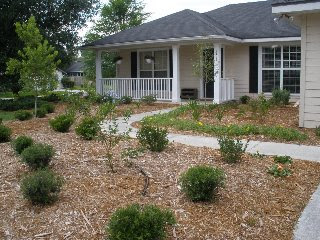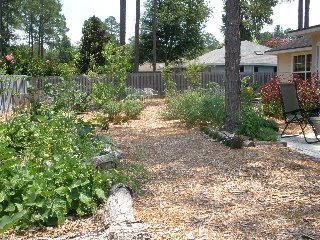In mid-2008, Patsy Murray relocated to Gainesville from Boston. Her goal was to transform her yard into a sustainable landscape that would conserve water and energy, as well as produce food for her family. One year later, Patsy is happy with the huge changes in her yard.
This is her original front yard with a wide expanse of turf and some shrubbery around the home.
 The first task was to remove the grass and existing shrubs so the transformation could begin.
The first task was to remove the grass and existing shrubs so the transformation could begin.
In March 2009 the planting was complete. She told me, "Some neighbors "get it" and some don't. The ones who get it probably have a philosophy similar to ours of preserving as much water and labor as possible by planting low maintenance, Florida-friendly plants and minimizing the grass." Her house quickly became known as "the mulch house" in the neighborhood.

Two months later (May) the plantings were growing nicely and beginning to cover the mulch. One of Patsy's favorite plants is the Beach Dune Sunflowers located to the right of the front walkway. She said, "They are a wonderful, colorful and fast-growing groundcover which provides me with cheerful flowers for cutting." Other flowering perennials include purple and red salvias, Indian hawthorne, butterfly bushes, Texas sage, passion flower vine, honeysuckle vine and plumbagos.

Now, for the backyard. A clean slate and a manageable size. A view to the left.

And a view to the right.
 The plantings are in, and I'll bet her husband isn't missing mowing the lawn in the heat and humidity of summer.
The plantings are in, and I'll bet her husband isn't missing mowing the lawn in the heat and humidity of summer.
A view from the back corner.
 And, in May they were enjoying Okinawa spinach, cranberry hibiscus (for salads), rosemary, as well as other vegetables and herbs that she grows in raised beds. Other edible plants include blueberries, figs, peaches, avocado and pineapple guava.
And, in May they were enjoying Okinawa spinach, cranberry hibiscus (for salads), rosemary, as well as other vegetables and herbs that she grows in raised beds. Other edible plants include blueberries, figs, peaches, avocado and pineapple guava. And, sweet potatoes spread in this section of the yard between the fence and the curb. This is just the beginning as Patsy experiments with more drought-tolerant flowering plants and edible herbs, vegetables and fruit.
And, sweet potatoes spread in this section of the yard between the fence and the curb. This is just the beginning as Patsy experiments with more drought-tolerant flowering plants and edible herbs, vegetables and fruit.
Being new to Florida, Patsy solicited the help of two local landscapers in the selection of plants. Denise Weber of Green Harmony Landscape Design suggested the plants and perennials that add color to her yard while conserving water. And, she worked with Joe Floyd of Abundant Edible Landscapes in choosing the best varieties of herbs, vegetables and fruit trees.

As Patsy continues to learn more about sustainable gardening, through trial and error she has started a blog to share what she learns with other Floridians. You can keep up with Patsy's garden by visiting her Grow Food Not Grass blog.

As Patsy continues to learn more about sustainable gardening, through trial and error she has started a blog to share what she learns with other Floridians. You can keep up with Patsy's garden by visiting her Grow Food Not Grass blog.
As water restrictions continue it will be necessary for Floridians to find new and innovative ways to garden. Patsy you've done a great job with your transformation, and I'll be dropping by your blog, on a regular basis, to learn more about what works in your Florida yard.
Note to readers: If you have made changes to your Florida yard to eliminate grass and grow more fruit, vegetables and/or drought-tolerant plants, and would like to share your experiences with us, please send me an email (smyers25@tampabay.rr.com). Thanks.
See other "sustainable gardens" in Florida.
See other "sustainable gardens" in Florida.
